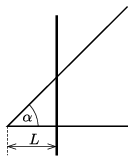 Problem P. 5415. (May 2022)
Problem P. 5415. (May 2022)
P. 5415. From a piece of wire of negligible resistance a V shaped figure was bent. The wire has no insulation, the angle between the two parts of the V is \(\displaystyle \alpha= 45^\circ\). It is placed horizontally into a magnetic field whose induction \(\displaystyle \boldsymbol B\) is perpendicular to the plane of the wire. The magnitude of this induction \(\displaystyle \boldsymbol B\) changes with time according to \(\displaystyle B(t)=B_0/t_0\cdot t\), where \(\displaystyle B_0\) and \(\displaystyle t_0\) are known constants. A metal rod, also without insulation, is placed onto the V shaped wire, initially it is fixed, as shown in the figure. The resistance of a unit length of the rod is \(\displaystyle r\).

\(\displaystyle a)\) How much heat is produced in the metal rod in a time of \(\displaystyle t_0\)?
\(\displaystyle b)\) At time \(\displaystyle t_0\) from the moment of switching on (time \(\displaystyle t=0\)), the change in magnetic induction ceases. At this instant we begin to move the metal rod (which was fixed till this time) in the horizontal plane and perpendicularly to the rod at a constant speed of \(\displaystyle v_0\). What should this speed be in order that the value of the current in the rod should not change?
\(\displaystyle c)\) By what factor will the heat produced in the moving rod be greater than that produced in a static rod, if the rod is moved for a time of \(\displaystyle 2t_0\)?
(5 pont)
Deadline expired on June 15, 2022.
Sorry, the solution is available only in Hungarian. Google translation
Megoldás. \(\displaystyle a)\) A derékszögű háromszög területe \(\displaystyle L^2/2\), a rajta áthaladó mágneses fluxus
\(\displaystyle \Phi=\frac{L^2}{2}\cdot B(t)=\frac{L^2}{2}\cdot\frac{B_0}{t_0}t,\)
a fluxus változásnak sebessége, vagyis a nyugalmi indukció folytán indukálódó feszültség:
\(\displaystyle U=\frac{\Delta \Phi}{\Delta t}=\frac{B_0L^2}{2t_0}.\)
Az \(\displaystyle L\) hosszúságú vezető ellenállása \(\displaystyle Lr\), így az áramerősség
\(\displaystyle I=\frac{U}{R}=\frac{B_0L}{2t_0r},\)
vagyis a \(\displaystyle t_0\) idő alatt fejlődő hő
\(\displaystyle Q_1=UIt_0 ={I^2}Rt_0=\frac{B_0^2L^3}{4t_0r}.\)
\(\displaystyle b)\) A \(\displaystyle B_0\) erősségű mágneses térben mozgó vezetőben a mozgási indukció folytán feszültség indukálódik. A vezetőnek a V alakú huzal közötti része \(\displaystyle t\) idővel a mozgás kezdete után \(\displaystyle L+v_0t\), így az indukált feszültség
\(\displaystyle U(t)=B_0(L+v_0t)v_0,\)
az áramerősség pedig
\(\displaystyle I(t)=\frac{U(t)}{R(t)}=\frac{B_0(L+v_0t)v_0}{(L+v_0t)r}=\frac{B_0v_0}{r}.\)
(Látható, hogy az áramerősség időben nem változik.)
A még mozdulatlan és a már mozgó fémrúdban az áramerősség ugyanakkora:
\(\displaystyle \frac{B_0L}{2t_0r}=\frac{B_0v_0}{r}, \qquad \text{vagyis}\qquad v_0=\frac{L}{2t_0}.\)
\(\displaystyle c)\) A fémrúd áramot vezető részének hossza az induláskor \(\displaystyle L\), \(\displaystyle 2t_0\) idővel később \(\displaystyle L+2v_0t_0=2L\). Így a vezető ellenállása időben egyenletesen \(\displaystyle Lr\)-ről \(\displaystyle 2Lr\)-re növekszik, a hőfejlődés teljesítménye pedig \(\displaystyle P_1=I^2R_1\)-ről \(\displaystyle P_2=I^2R_2=2P_1\) nagyságúra változik. Mivel a változás egyenletes, számolhatunk az átlagteljesítménnyel, és így a \(\displaystyle 2t_0\) idő alatt fejlődő hő összesen
\(\displaystyle Q_2=2t_0\frac{P_1+P_2}{2}=\frac{3B_0^2L^3}{4t_0r}=3Q_1. \)
A mozgatás során tehát 3-szor több hő fejlődik a fémrúdban, mint a rögzített helyzetben.
Statistics:
15 students sent a solution. 5 points: Gábriel Tamás, Kertész Balázs, Molnár Kristóf, Somlán Gellért, Téglás Panna, Toronyi András, Veszprémi Rebeka Barbara. 4 points: Hegedűs Máté Miklós, Nemeskéri Dániel. 3 points: 3 students. 2 points: 3 students.
Problems in Physics of KöMaL, May 2022
